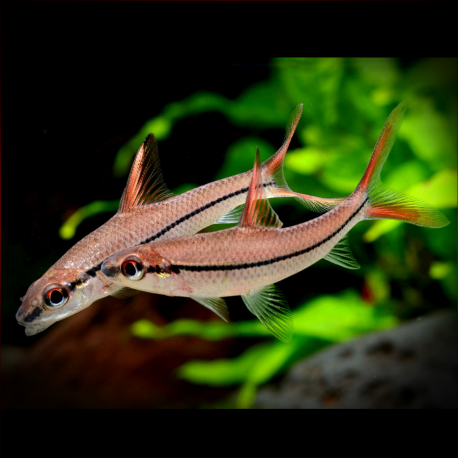More info
Datasheet
| Minimum Tank Size | 370 litres / 97.74 US gallons |
| Maximum Size | 20.0cm / 7.87inches |
| Temperature | 22°C / 71.60°F - 27°C / 80.60°F |
| Hardness | 1.01dgH / 18ppm - 10.03dgH / 179ppm |
| pH | 4.0-7.0 |
General Description
Cyclocheilichthys Janthochir, commonly known as the violet-gilled barb, is a peaceful and unique addition to larger aquarium setups. This species features distinctive red markings in the dorsal and caudal fins, along with a dark lateral stripe on the body. Belonging to the Cyprinidae family, these fish possess a serrated dorsal fin spine, a conical snout, and small, subterminal mouths. They are usually identified by their parallel rows of sensory folds on the snout and cheeks.
Aquarium Setup
For optimal care, C. Janthochir requires a tank of at least 370 liters with well-maintained water conditions, including a pH of 4.0-7.0, hardness of 18-179ppm, and a temperature range of 22-27°C. A well-furnished aquarium with ample open swimming space is ideal. Setting up a peat swamp-like environment with dim lighting, roots, branches, and leaf litter can enhance their coloration, as they thrive in slightly stained water with tannins. Aquatic plants such as Microsorum, Taxiphyllum, and Cryptocoryne spp. can also be added to mimic their natural habitat.
Behaviour
C. Janthochir is a gregarious species that thrives in groups of at least six individuals. They exhibit better colors and natural behavior when kept with conspecifics. These fish are peaceful in community setups but may intimidate slower or timid tankmates due to their size. It is important to research and carefully select compatible tankmates to ensure a harmonious environment.
Feeding and Diet
In the wild, C. Janthochir mainly feeds on aquatic and terrestrial invertebrates, particularly insects. In captivity, they accept a varied diet, including live and frozen foods like bloodworms, Daphnia, Artemia, along with high-quality dried flakes and granules. Larger specimens particularly enjoy chopped prawn or shrimp. Maintaining a regular feeding schedule will help promote their vibrant colors and overall well-being.
Reproduction & Dimorphism
There is limited information about the reproduction of C. Janthochir in aquarium settings, suggesting that breeding might not have been successfully documented. Sexually mature females are likely to be thicker-bodied and possibly less colorful compared to males. However, distinguishing between sexes can be challenging without observing breeding behavior or specific physical characteristics.
Habitat and Distribution
Endemic to the island of Borneo, C. Janthochir is found in black water streams and rivers within ancient forest peat swamps. These habitats are characterized by soft, acidic water with a pH as low as 3.0-4.0 and are often dimly lit due to the forest canopy. Conservation efforts are crucial as these unique biotopes are under threat from various human activities like deforestation and agricultural developments. In the Danau Sentarum lake system of West Kalimantan, C. Janthochir coexists with various species such as Scleropages formosus, Barbonymus spp., and Epalzeorhynchos kalopterus, among others.

